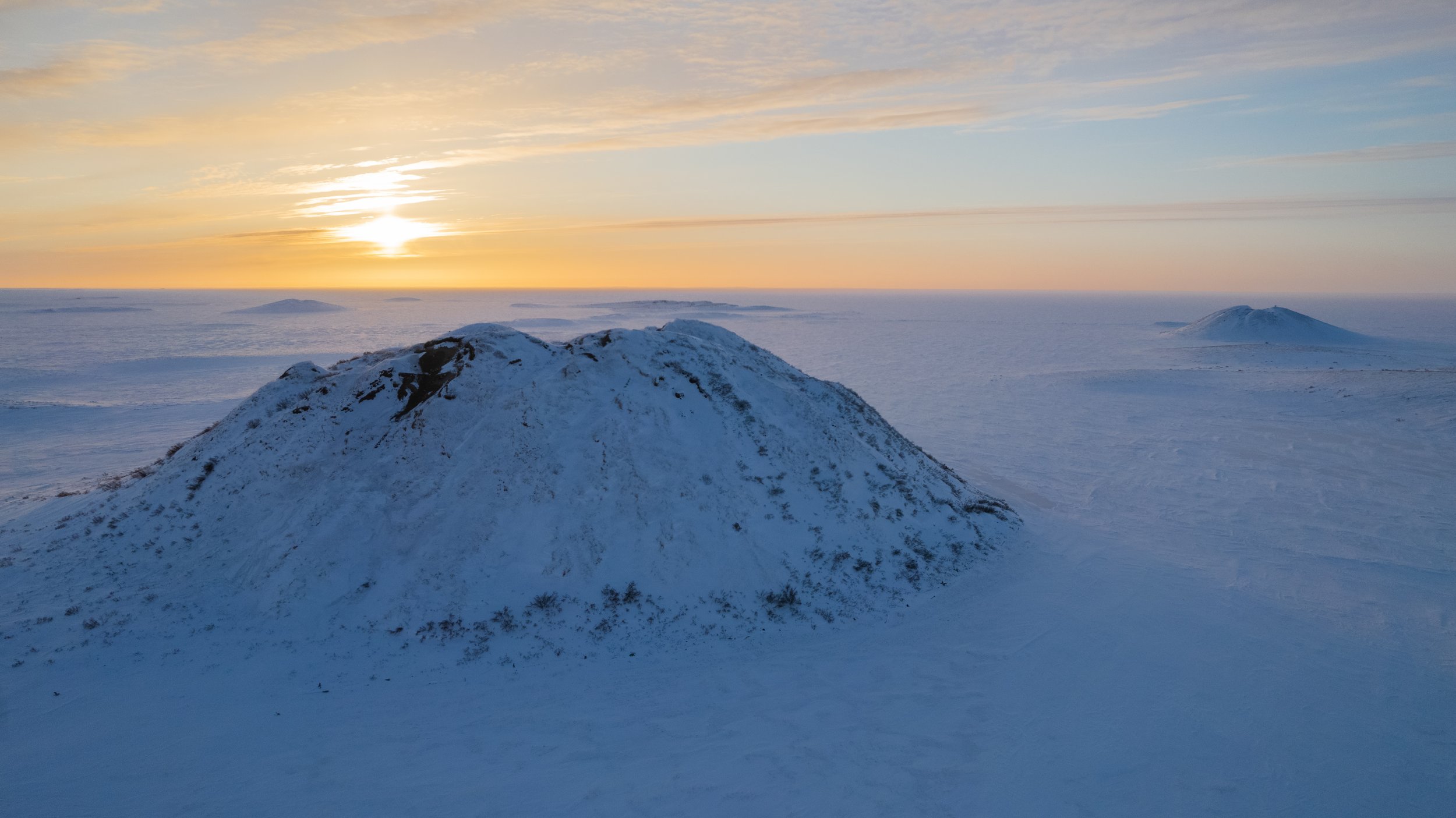Land of the Pinguqsaaryuit
Some of the most iconic landmarks of the Western Canadian Arctic are the rising pinguqsaaryuit - the Inuvialuktun word for pingos - that emerge from the relatively flat land and water that surrounds them. These gentle features have marked the area for thousands of years, inspiring stories, traditions and, of course, art.
Maureen Gruben knows the enduring importance of the pinguqsaaryuit. “The pingos are a landmark for Inuvialuit people - they always have been for generations past.”
The pinguqsaaryuit have always served as landmarks for the Inuvialuit who have lived and travelled the Western Arctic. With almost a quarter of all the pinguqsaaryuit in the world being so close to Tuk, they make up a deeply personal part of the experience with the land for many people.
“The pingos were used as a landmark if you were coming out from the ocean,” Roy Cockney explains. “Because of the pingos, you could exactly know where Tuk is. Probably about 10 or 12 miles out on the ocean coming into land, the first thing you see is the pingos.”
A pinguqsaaryuk - a single pinguqsaaryuit - grows when permafrost pushes up from underneath the surface, absorbing water around from the many lakes, which then collects, freezes, and pushes the mound of the pinguqsaaryuk even further. This process happens very slowly - it takes about 1000 years for a pinguqsaaryuk to grow to the notable sizes seen around Tuk. Growing at a rate of approximately three inches per year, the change is slow, but noticeable to the people who live in the area who have watched them grow over a lifetime.
Roy recounts, “I remember the first time I'd seen the pingos. I recall one time after 10 years, it was a little bit bigger. I would go there and look around and I’d notice somehow it’s just a little bit bigger. And today it’s still growing.”
The pinguqsaaryuit are used for wayfinding, but they have also provided for the people of the Western Arctic in many ways. They are important places for Inuvialuit to visit - camping, collecting the cranberries that grow in large concentrations, and getting out on the land.
Familiarity doesn’t change their significance to Maureen. “They’re my everyday view - I wake up and I see the pingos. But I also go there quite often. It’s a place where I've camped by myself, I’ve tattooed myself. They are very personal to me.”
Maureen Gruben in her home overlooking the pinguqsaaryuit.
As such an important and everlasting feature of the areas around Tuk, pinguqsaaryuit are an important part of Inuvialuit culture - in the stories, landmarks, and art. Their gentle hilly shapes can be seen around borders, as the subject of paintings, or in sewing and beadwork. From the animals that live around them come bones and furs and from the plants that grow on them come colours and dyes. Life around the pinguqsaaryuit is represented in carvings, painting, fashion, and stories.
The stunning views of the Western Arctic that surrounds the pinguqsaaryuit - the land, the ocean and the sky - inspires creativity in all forms. The significance and wonder that comes from seeing a pinguqsaaryuk are shared by Inuvialuit artists of Tuk and visitors alike.
Appreciation of the pinguqsaaryuit can be as simple as a stunning view. Bruce Noksana knows this. “People just love it - they’re beautiful things to see. Take some pictures, you’ve got the ocean air. It’s a nice sight. ”
As the pinguqsaaryuit have always informed the arts, it was fitting that they informed the centre as well. Two of Tuktoyaktuk’s largest and most notable pinguqsaaryuit, Ibyuk and Split, serve as a landmark for the future home of Saliqmiut: Tuktuuyaqtuuq Centre for Arts and Culture. Once built, these pinguqsaaryuit will greet guests as they wind the road into Tuk and mark the landscape view from the front doors.
Episode 6 of our 8-part Saliqmiut mini-documentary series is out now. Land of the Pinguqsaaryuit is about pinguqsaaryuit being an important and everlasting feature of Tuk and how continue to inspire stories, traditions and of course, art. Check it out below!
As always, be sure to follow our social channels (links at the bottom of this page) to be the first to know when a new episode is released!



